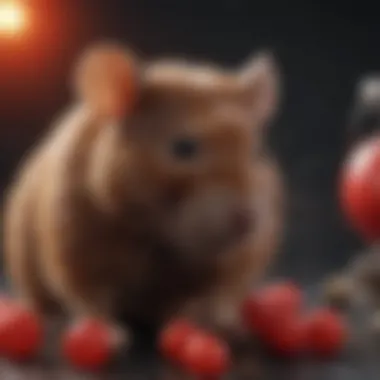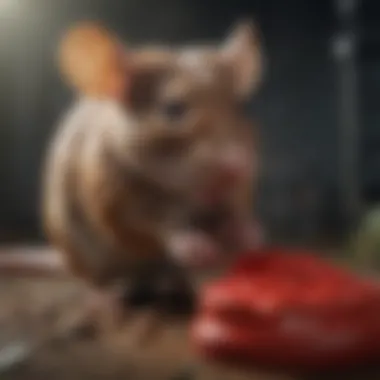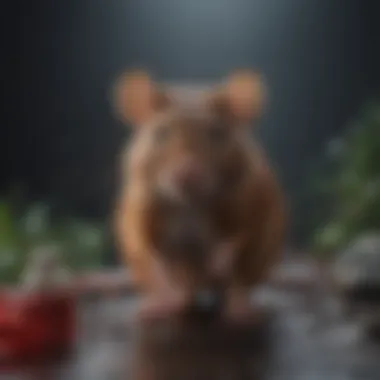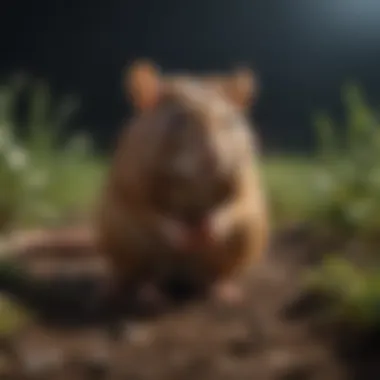Red Rat Poison: Composition, Uses, and Risks Explained


Intro
Red rat poison is a critical topic in pest management, particularly for urban environments where rodent infestations can create severe health and safety concerns. Understanding its composition and usage allows for informed decisions regarding pest control while also addressing the risks presented to humans and wildlife. This article aims to illuminate the complexities surrounding red rat poison, encouraging responsible practices and highlighting alternative methods for effective rodent management.
Research Overview
Summary of Key Findings
Recent studies have shed light on the specific chemical compounds found in red rat poison, including anticoagulants like bromadiolone and brodifacoum. These compounds disrupt blood clotting in rodents, leading to fatal outcomes when ingested. Research indicates that while these poisons are effective in reducing rodent populations, they also pose significant risks to non-target species, including pets and wildlife. In light of this, it is crucial to explore the usage of red rat poison within a framework that prioritizes safety and environmental health.
Relevance to Current Scientific Discussions
The discourse surrounding rodent control is increasingly essential, particularly as urbanization expands. Red rat poison often finds itself at the center of debates regarding ecological balance and public health. By examining the relevant studies, practitioners can navigate the complexities associated with using red rat poison more responsibly. This connects with broader conversations about sustainable pest management approaches and is pertinent for students, researchers, and professionals in the field.
Methodology
Research Design and Approach
This article employs a comprehensive review of existing literature on the composition, effectiveness, and risks associated with red rat poison. It synthesizes information from various sources, including scientific journals and regulatory frameworks, to provide a well-rounded perspective.
Data Collection and Analysis Techniques
Data is drawn from peer-reviewed studies, expert reports, and official regulatory guidelines. The analysis focuses on understanding both the mechanisms of action of red rat poison and its safety protocols. A thorough examination of alternative pest control methods is also included to present a balanced view.
"It is essential to consider both the effectiveness of a solution and its broader impact on the environment, emphasizing a responsible approach to pest control."
Intro to Red Rat Poison
The topic of red rat poison is crucial in pest control discussions. Understanding this substance can aid in addressing rodent problems while considering health and environmental implications. Red rat poison not only plays a role in managing pest populations but also poses significant risks to humans and animals.
The composition and functioning of red rat poison are essential for effective application. Knowledge of its active ingredients allows for informed decisions on usage and safety measures. Additionally, awareness of historical developments helps highlight the evolution of pest control practices over time.
Overall, examining red rat poison provides an insight into its necessity in modern pest control and the ethical considerations surrounding its use.
Historical Context and Development
Red rat poison has its roots in the mid-20th century when it emerged as a solution for controlling rodent populations. Early formulations were simple yet effective, primarily utilizing compounds like warfarin. As research progressed, manufacturers began to develop more sophisticated variants. These contained newer chemicals that were more potent and required smaller quantities for effective results.
The understanding of rodent behavior also informed the formulation process. Developments in animal physiology studies led to the creation of poisons that distracted rodents from traditional food sources, compelling them to consume the bait. This shift in approach highlighted a more strategic methodology in pest control rather than simply relying on lethal traps.
Current Relevance in Pest Control
In contemporary settings, red rat poison remains a primary tool for managing rodent infestations. Its efficacy is largely attributed to its ability to rapidly reduce rodent populations in urban areas, where food sources and shelter encourage high fertility rates among rats. Pest control firms rely on these poisons due to their practicality and efficiency.
However, the relevance of red rat poison goes beyond mere population control. Social awareness regarding pest management has intensified, prompting discussions on safe application and the potential risks to non-target species. As per regulations, these poisons must be used responsibly to mitigate hazards to humans and pets. For instance, scratching or gnawing can lead to accidental ingestion, leading to serious health threats.
In summary, understanding both the historical and current relevance of red rat poison is significant for effective pest control implementations. Education about its properties ensures that users apply it with caution, balancing effectiveness against environmental responsibility.
Chemical Composition of Red Rat Poison
Understanding the chemical composition of red rat poison is crucial for multiple reasons. First, it helps in grasping how the poison works to eliminate rodents effectively. Second, knowledge about its components allows for safer handling and usage. Lastly, it positions consumers and professionals to make informed decisions regarding their pest control strategies. Different formulations have unique characteristics, which can impact both their efficacy and safety. As such, a thorough understanding of these elements is necessary in this discourse.
Key Active Ingredients


Red rat poisons primarily utilize anticoagulants as their active ingredients. Two common examples include brodifacoum and bromadiolone. These substances work by disrupting the blood-clotting process in rodents. Notably, they cause internal bleeding, which is often a slow and painful way for rodents to perish. This delayed action can be advantageous because it allows the poison to be consumed multiple times, potentially increasing its effectiveness before the rodent realizes the danger.
Additional active ingredients may include phosphorus compounds, which affect the nervous system. Phosphides are another option that acts rapidly, leading to quick death. Each ingredient possesses unique mechanisms that jointheory can be utilized effectively but must be handled with care to avoid unintended impacts on non-target species.
Moreover, the concentration of these active ingredients can vary significantly across different products. Some formulations might be designed for residential use, while others are more suitable for commercial applications. Therefore, interpreting the active ingredient list is essential for understanding the appropriateness and safety of the product in varying contexts.
Formulation Variants
Formulation variants of red rat poison are significant in determining how they are applied and their overall effectiveness. Common presentation forms include granules, blocks, and liquids. Each variant has specific characteristics that impact how they are used and their efficiency in eradicating pests.
- Granules: These are versatile but depend on moisture and placement for effectiveness. They can be scattered easily in affected areas, making them suitable for outdoor settings.
- Blocks: Often formulated to resist moisture, these might last longer and can be placed securely where rodents are likely to gnaw. Their shape may make them less attractive to non-target wildlife.
- Liquids: These formulations can penetrate areas that solid forms cannot. They may offer a quicker action since rodents may consume them with little hesitation.
Furthermore, there are various combinations of attractive additives involved to ensure that rodents are drawn to the poison. The choice of formulation can hinge on factors such as location, the type of rodent being targeted, and safety concerns for other animals and humans.
By examining these notable aspects of the chemical composition of red rat poison, readers can appreciate why certain products are formulated differently and how effective use can significantly mitigate rodent populations.
Mechanisms of Action
Understanding the mechanisms of action of red rat poison is crucial for comprehending its effectiveness and potential hazards. This section delves into how the active ingredients impact the physiology of rodents and what symptoms manifest during poisoning. Knowing these details aids in formulating safer pest control strategies and recognizing when intervention is necessary.
How It Affects Rodent Physiology
Red rat poison primarily functions by disrupting essential physiological processes in rodents. The main active ingredients found in these poisons include anticoagulants, such as bromadiolone or brodifacoum. These compounds inhibit the synthesis of vitamin K, which is vital for proper blood clotting.
When a rodent ingests this poison, the absorption leads to a cascade of effects. The blood becomes unable to coagulate properly, resulting in internal bleeding. The rodents may appear healthy initially; however, they suffer from undetected hemorrhaging. This slow, painful death is one of the critical reasons for its use in pest control, as it can reduce the likelihood of rodents associating the bait with the actual cause of death.
Moreover, the poison affects the liver's ability to host metabolic processes necessary for survival. Eventually, the combination of these effects results in lethargy, loss of appetite, and other systemic failures that lead to death over several days.
Symptoms of Rodent Poisoning
Identifying the symptoms of poisoning in rodents is vital for understanding the impact of red rat poison. Often, by the time symptoms become apparent, significant internal damage may have already occurred. Common signs include:
- Lethargy: Rodents will appear less active or may hide more than usual.
- Loss of Appetite: A marked reduction in feeding behavior is typical.
- Difficulty Breathing: Indications of respiratory distress can occur as internal bleeding puts pressure on organs.
- Physical Weakness: Rodents may seem uncoordinated or stumble.
- Visible Bleeding: In advanced cases, bleeding from the nose or mouth can be observed.
Identification of these symptoms can help in assessing the efficiency of a pest control strategy.
Practical Applications in Pest Control
Understanding the practical applications of red rat poison is essential for effective pest management strategies. This substance plays a significant role in controlling rodent populations, especially in urban and rural settings where infestations lead to public health risks and property damage. However, the deployment of red rat poison requires a thoughtful approach, as improper use can lead to unintended consequences for both human and ecological health.
One of the primary benefits of red rat poison lies in its effectiveness. When applied correctly, it can swiftly reduce rodent numbers, minimizing their impact on food storage, property infrastructure, and the transmission of diseases such as hantavirus and leptospirosis. This quick reduction is vital in emergency situations, such as when there is a sudden spike in rodent sightings.
However, considerations such as safety, regulatory compliance, and environmental impact must also be factored into its use. Applicators must be aware of the legal regulations regarding red rat poison in their location. Misuse can result in legal ramifications and further complicate pest management efforts.
Common Usage Scenarios
Red rat poison is typically utilized in various scenarios, including:
- Residential Settings: Homeowners often find themselves dealing with rodent infestations, particularly in basements or attics. The use of red rat poison can be an effective solution if applied judiciously.
- Commercial Facilities: Businesses such as restaurants and food warehouses are frequent targets for rodents. Effective rodent control using poison can prevent significant health inspections issues and financial losses.
- Agricultural Areas: Farmers may utilize red rat poison to protect crops from rodent damage. This is especially critical during harvest time when rodents can cause extensive damage to stored grain.
- Urban Environments: Red rat poison is also commonly employed in cities where covert entry points allow rodents to easily invade buildings. Timely applications can prevent serious infestations.
"When it comes to pest control, understanding the specific context of the infestation is key to effective use of red rat poison."
Best Practices for Application


To maximize the effectiveness of red rat poison while minimizing risks, users should adhere to several best practices:
- Read and Follow Label Instructions: Always start by carefully reading the label. It contains vital information on dosages and safety precautions specific to the product.
- Determine Rat Species: Identifying the specific species of rodent can help in choosing the most effective poison formulation, as different species may react differently to active ingredients.
- Use Bait Stations: Employ bait stations to contain the poison. This can help prevent accidental ingestion by non-target animals and children. It also protects the bait from environmental factors that may make it less effective.
- Location and Placement: Place poison strategically in areas with high rodent activity. Common locations include behind appliances, along walls, and in dark corners. Ensure that these areas are inaccessible to pets and children.
- Monitor and Evaluate: Regularly check bait stations and inspect for signs of rodent activity. Adjust strategies as necessary based on monitoring results.
- Educate Others: In shared environments, such as workplaces or community areas, ensure all parties understand proper usage and safety measures related to red rat poison.
By implementing these practices, those involved in pest management can effectively utilize red rat poison while maintaining a commitment to safety and environmental responsibility.
Health Risks to Humans and Pets
Understanding the health risks associated with red rat poison is crucial, not only for pest control professionals but also for homeowners and pet owners. Red rat poison, containing potent anticoagulants and other toxic substances, poses significant threats to both human health and the well-being of pets. As these risks become more evident, it is essential to inform and educate the public on safe handling practices, potential exposure scenarios, and effective emergency responses.
Acute and Chronic Exposure Effects
Acute exposure to red rat poison typically occurs when humans or pets accidentally ingest the substance. The effects can manifest quickly, primarily affecting the blood's ability to clot, leading to severe internal bleeding. Symptoms may include nausea, dizziness, and abdominal pain. In pets, the signs can appear as lethargy, difficulty breathing, or unexplained bruising.
Chronic exposure, while less common, can result from repeated contact with the poison in various forms, such as residue left in the environment. Prolonged exposure can lead to cumulative effects on health, including anemia and organ dysfunction. Understanding the nature of these exposures is critical for appropriate preventive measures.
Symptoms of Poisoning in Humans
Recognizing the symptoms of poisoning is vital for timely intervention. In humans, signs of red rat poison exposure can include:
- Unexplained bruises or bleeding
- Severe headaches
- Shortness of breath or difficulty breathing
- Jaundice, indicated by a yellowing of the skin or eyes
These symptoms may not appear immediately after exposure, as the effects take time to develop. It is important to monitor individuals who may have been exposed, even if initial signs are absent.
Emergency Response and First Aid
Immediately acting in the event of suspected poisoning is essential. The first response should focus on assessing the situation carefully:
- If the poison is ingested, do not induce vomiting unless directed by a medical professional.
- Call emergency services or a poison control center for guidance.
- If safety allows, provide the victim with activated charcoal, which can help absorb the poison if done promptly.
For pets, taking similar immediate actions is necessary. Reach out to a veterinarian while providing as much information as possible about the potential exposure. Timely intervention can significantly improve the prognosis for both humans and pets affected by red rat poison.
Environmental Impact
Understanding the environmental impact of red rat poison is critical. This topic encompasses the broader implications of its use beyond immediate pest control. While these substances can effectively reduce rodent populations, they can also have significant consequences for ecosystems. Both humans and wildlife are part of these delicate systems. Here, we analyze two essential components of environmental consequences: effects on non-target species and the persistence of the poison in ecosystems.
Effects on Non-target Species
When using red rat poison, there is a risk of affecting non-target species. This includes other wildlife such as birds, mammals, and reptiles. The chemicals in rat poison can be toxic if ingested by these species, leading to unintended deaths. For example, birds of prey may consume poisoned rodents and end up poisoned themselves. Studies have shown that certain anticoagulant rodenticides have been implicated in the decline of raptor populations.
- Species at Risk:
- Birds of prey such as owls and hawks.
- Scavengers including foxes and raccoons.
- Pets and domestic animals.
To mitigate such risks, factors such as placement and timing of the bait must be considered. Careful monitoring is necessary to observe any unintended consequences in wildlife populations.
Persistence in Ecosystems
The reliability of red rat poison also relates to how it remains in the environments where it is released. Chemical persistence is an important characteristic. Many rodenticides do not break down quickly in the ecosystem. As they accumulate, they can cause long-term contamination of soil and water.
- Key Concerns:
- Bioaccumulation in the food chain.
- Effects on soil and aquatic systems.
- Increased risks for future generations of wildlife.


Some ingredients may linger for extended periods, posing risks long after application. Understanding this persistence is essential. It guides actions to minimize environmental footprints while effectively managing rodent populations.
Regulatory Considerations
Understanding the regulatory framework surrounding red rat poison is crucial for ensuring safe usage and effective pest control. Regulations aim to balance the effectiveness of these poisons with the potential risks they pose to humans, pets, and the environment. By adhering to legal guidelines, users can minimize harmful consequences and promote responsible management of rodent populations.
Legislation Governing Use
Various governments implement strict legislation regarding the use of red rat poison. This legislation typically includes regulations about the sale, distribution, and application of these toxic substances. Some common elements of such legislation are:
- Registration and Approval: Manufacturers must register their products with appropriate environmental agencies, providing detailed information on their chemical composition and potential hazards.
- Labeling Requirements: All rodenticide products must include clear and comprehensive labels. These labels detail usage instructions, safety precautions, and first aid measures.
- Restricted Use Areas: Certain regions may prohibit the use of red rat poison due to high risks to non-target species or human populations. Examples include near schools, parks, and bodies of water.
Compliance with these regulations helps in fostering safe pest control practices and protecting public health.
Safety Guidelines for Users
The safe handling and application of red rat poison require adherence to specific guidelines. These guidelines aim to reduce the risk of accidental poisoning, environmental contamination, and harm to non-target species. Key safety recommendations include:
- Use Personal Protective Equipment: Such as gloves, masks, and goggles, to prevent direct contact with the poison.
- Follow Manufacturer Instructions: Always abide by the labels regarding dosage and placement to ensure effectiveness and safety.
- Secure Storage: Keep poisons in locked containers, out of reach of children and pets, to prevent accidental ingestion.
- Dispose Properly: Unused or expired products should be disposed of in accordance with local regulations to minimize environmental impact.
- Stay Informed: Regularly check for updates on local legislation regarding the use of rodenticides to remain compliant with current laws.
Proper regulation and adherence to safety guidelines can significantly reduce the risks associated with red rat poison.
Following these guidelines ensures effective pest control while mitigating potential dangers. Awareness of the legal landscape surrounding red rat poison is essential for responsible use.
Alternatives to Red Rat Poison
The topic of alternatives to red rat poison is increasingly important in discussions surrounding pest control. As the concerns about the environmental impact and health risks of traditional poison methods grow, so too does the need for more sustainable and humane strategies. It is vital to explore different methods that can manage rodent populations effectively while minimizing risks to human health and the ecosystem. This section will discuss non-toxic pest control methods and integrated pest management practices, both of which offer viable alternatives.
Non-toxic Pest Control Methods
Non-toxic pest control methods prioritize safety for humans and pets while still addressing rodent issues. These methods can be highly effective when implemented properly. Some common examples include:
- Snap Traps: Traditional snap traps provide a rapid, humane way to eliminate rodents without chemicals. They are easy to set up and observe.
- Live Traps: These traps capture rodents alive, allowing for relocation. However, care must be taken to release them at a significant distance from residential areas to prevent return.
- Natural Repellents: Substances like peppermint oil can deter rodents when applied around entry points and areas of activity. This method is an example of using natural ingredients to create a less inviting environment for pests.
- Ultrasonic Pest Repellers: These devices emit high-frequency sounds that are said to disturb rodents. Their effectiveness is debated, but they are chemical-free and easy to deploy.
These methods not only address the immediate problem of rodent presence but also contribute to a more sustainable approach by reducing reliance on hazardous chemicals.
Integrated Pest Management Practices
Integrated Pest Management (IPM) is a holistic approach that combines multiple strategies to manage pest populations sustainably. This method emphasizes the following key components:
- Monitoring and Assessment: Regular inspections of the environment help in identifying rodent populations and understanding their behaviors. By knowing how and when rodents invade, one can plan interventions more effectively.
- Exclusion Techniques: Sealing entry points in buildings, such as gaps around pipes and vents, is crucial. This physical barrier can significantly reduce rodent access, making it a foundational strategy in IPM.
- Habitat Modification: Maintaining a clean and organized environment is essential. Remove clutter and potential nesting sites, and store food properly. This discourages rodents from settling in.
- Biological Control: Introducing natural predators, like owls or other birds of prey, can help manage rodent populations. This approach supports ecological balance without resorting to poisons.
- Education and Awareness: Teaching community members about rodent behaviors and preventive measures fosters a collective effort in pest control. Reducing food sources available to rodents can lead to significant declines in population.
"Integrated Pest Management emphasizes prevention and relies on a combination of strategies to create effective pest control without harmful chemicals."
The End
The conclusion serves as a pivotal point in understanding the multifaceted nature of red rat poison. It synthesizes the various elements discussed throughout the article, elucidating the critical aspects of composition, utility, and safety associated with its use in pest control. This topic is highly relevant, especially in the context of environmental conservation, health risks, and regulatory frameworks.
Summary of Key Points
- Red rat poison contains active ingredients that target the physiological mechanisms of rodents, resulting in effective pest control. However, these same compounds can pose significant risks to non-target species, including humans and pets.
- The practical applications of red rat poison must be balanced with awareness of its potential hazards. Best practices in its application are vital to minimize exposure and risks.
- Understanding the environmental impact is crucial as it informs both users and regulators on best practices that sustain ecological integrity while managing rodent populations effectively.
- There are alternative pest control methods available that can reduce reliance on chemical solutions, promoting a more integrated approach to pest management.
Future Directions in Pest Control Research
As pest control methods evolve, future directions in research should focus on the development of less harmful alternatives to red rat poison. Here are key areas for exploration:
- Biological control: Researching natural predators of rodents can provide sustainable means of managing infestations without chemical intervention. This would help maintain ecological balance.
- Pharmacological advancements: Investigating novel compounds that target rodents specifically while being safe for other wildlife. This could lead to more efficient and safer pest control strategies.
- Public awareness campaigns: Enhancing community education about the risks associated with traditional poisons and promoting safer alternatives. Education can play a significant role in reducing accidental poisonings.
- Regulatory improvement: Advocating for stricter regulations surrounding the manufacturing and application of rodenticides. This can ensure safer practices within the pest control industry.
Overall, the conclusion of this exploration emphasizes the necessity of a cautious and informed approach to using red rat poison, balancing effectiveness in pest control with safety and environmental concerns.



